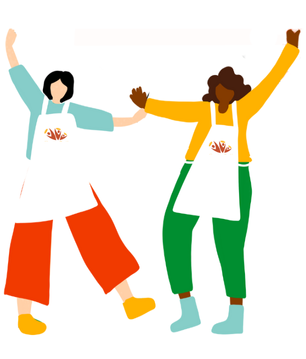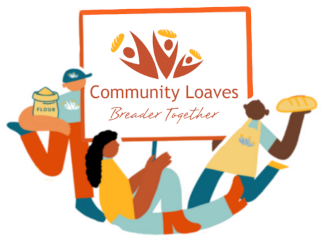FAQs → Hub Leaders – Everything You Need → Hub Leader Role
Answers to the most commonly asked questions can be found below. Still Stumped? Contact Us!
Hub Leader Role (4)
We don’t use the word “essential” lightly. Our ability to deliver loaves and energy cookies twice a month is dependent on a cheerleader coordinator within the community. This hub leader serves as an anchor for the volunteer bakers in a specific geographic area and in support of a specific food bank partner or partners.
A robust set of tools has been built to make the cheerleading easy to execute or to delegate to helpful volunteers.
On average the volunteer time needed to be a hub leader is 10 hours or so a month. Most of that is passive time, receiving the donations twice a month. But active time is what helps us build community and improve our impact to our food bank partners.
Here is a short list of the essential tasks to be a hub leader:
- Communication – twice a month email communication using the CL email tool. Provide meaningful updates and/or requests to your hub members. Topics include…
- New Program Logistics – (Holiday Cookie, New Formulas, Supply Delivery…)
- Major member milestones – (anniversaries, volunteer time, achievements)
- Request help from hub members – ask for assistance getting the donation to the food bank
- Reinforce the value of the donation to the food bank – updates from the partnered food bank.
- Manage Bread & Cookie Donation – ensure that the loaves and cookies get to the food bank. (This doesn’t mean taking them yourself, it is an easy task to request help from others.)
- Understand the monthly local delivery or shipment process for supplies. If you manage a local shipment that involves a couple of hours each month.
- Coordinate an annual food bank tour – individually or in concert with other hubs that support the same food bank. This is also a great “task” for an enthusiastic hub member.
What follows are the essential agreements to be a CL hub leader:
- Your Photo or Avatar will be part of your profile – this livens up the CL Community and creates a familiar face for hub members to find.
- The existing partnered food bank will be the exclusive beneficiary – you cannot solicit new partners independently, but working with Community Loaves HQ, new partnerships may be pursued as needed.
- Use the hub leader management tools exclusively for all CL functions.
- Ask bakers to use the support resources directly vs. serving as a liaison for logistics inquiries. Creates unnecessary complexity – FAQ’s. (orders@communityloaves.org, info@communityloaves.org )
- Stay in contact and elevate any concerns or recommendations directly to me – your ideas big or small, help us continue to build a stronger program – katherine@communityloaves.org
- Any and all press inquiries need to be directed to Community Loaves. From there we will respond as a team.
- All branding and communication elements are the property of Community Loaves and usage needs to be approved by the mothership.
- Creation of any tools – including handouts, flyers, cards, etc.. to support the Community Loaves effort need to be approved by Katherine Kehrli and the communications team.
The hub leadership was never intended to be a lifetime role. We recognize the time will come when you will be ready or will need to pass the proverbial baguette. The following process will help to guide this effort and create a smooth transition and continuity for our Breader Together efforts.
FYI – It is helpful to transition hubs at specific times of the calendar year when other activities for our non-profit are slower. If you can plan for an August or December transition, that is ideal. Life events don’t always happen at an ideal time, but if we have the luxury of time, August or December are best.
Here are the steps:
- Notify Katherine that you’re looking to find new leadership for the hub.
- Together, you’ll talk through any logical successor candidates, perhaps existing delegates and/or super helpful hub members.
- You’ll agree on a desired timeline and a communication plan to the hub to solicit interest.
- Any interested candidates will need to attend a hub training session. You and Katherine will encourage folks to attend this hub leader training.
- Although only one person can be a hub leader, the opportunity to train multiple people at once helps create a knowledgeable leadership team that can support one another.
- In the unlikely event that nobody emerges able/willing to take on these responsibilities, the hub will be closed, and hub members will be reassigned to the next closest hub.
Please notify Katherine (katherine@communityloaves.org) if you would like to begin the hub transition process.
Shared Leadership/Shared Responsibility – Baking A Difference Together
“Hubs thrive when their local community bands together to make the work happen.”
No two hubs or hub leaders are the same. Each has its own special talents and gifts for supporting this program. Nevertheless, there are essential attributes for every hub and hub leader that ensure the program’s success. Review the following leadership models and select one that works for you.
 Leadership Model: Co-Leadership
Leadership Model: Co-Leadership
We highly encourage Co-Leadership. This is defined as two dedicated individuals who understand and agree to share the role of Hub Leader. That doesn’t mean either does everything, but they work together seamlessly to ensure the full role is executed.
Why Co-Leadership Works:
- You have a partner.
- The work is easier and more sustainable thanks to the extra leadership.
- Two heads continue to be better than one.
- Co-leaders can lean into specific aspects of the work that fit their talents and interests.
- There is “baked in” support for vacation travel or unexpected emergencies.
- We all know how partnership encourages us all to “show-up.”
Adding shared leadership with volunteer delegates to your co-leadership model will further increase helping hands and decrease the work overall. (Read about the benefits of volunteer delegates below.)
Want to onboard a co-leader? We’ll help get you started! Email us at hubsupport@communityloaves.org
Leadership Model: Shared-Responsibility with Volunteer Delegates
Although we love the co-leadership model, it may not suit every situation. An alternative model is shared responsibility with volunteer delegates. Shared responsibility means recruiting volunteers from within your hub or neighborhood who are willing to step into your shoes periodically and/or for a specific ongoing role.
Why Shared Responsibility Works:
- Increased hub engagement; involving your volunteers creates more invested hub members.
- The work is more manageable and more sustainable thanks to the extra support
- There is “baked-in” support for vacation travel or unexpected emergencies.
- You can lean into your unique talents and interests and share the hub leader role(s) that could be a better fit for one of your hub members.
- The best run hubs are buzzy like a hive with several volunteers/bakers familiar with work and excited have a particular role or assignment to fulfill.
- By way of example – The Edmonds Hub uses the following leadership model:
- Lynn Behrendt – Hub Leader
- Marty Ronish – Communications Specialist
- Valerie Stein – Manages the Flour Delivery
- Laurie Tollefson & Paul Watkins – Who provides transport of the donation each donation on Monday
- Bob Witzgall – Edmonds Food Bank liaison
- By way of example – The Edmonds Hub uses the following leadership model:
Assigning a Delegate:
Assigning a delegate is so easy, and it is part of your Hub Leader Toolkit.
- First, invite a volunteer to help. Find out their talents and interests and match them with one of the hub’s essential tasks.
- Next click on “Delegate Duties” from your hub leader toolbar.

- On the Delegate Duties page, you’ll have a list of all hub members. Scroll down, find your volunteer, and then select “Delegate” from the drop-down box. Notice in the example below that you can give the individual a “specialty” if you want. Current options are “All-Rounder”– a volunteer capable of supporting you in any task, “Communication/Cheerleader”–someone interested in welcoming and cheerleading hub members via the communications tool, “Food Bank Donation” — an individual who is keen on taking the donation to the food bank, “Flour Delivery Organizer” –an individual who can help sort and prepare the flour delivery for baker pick-up.

- When you give a volunteer delegate status and assign them a delegate role, their volunteer dashboard automatically gets the hub leader tools for them to use to complete their role.
Best Practices When Asking For Help:
Asking for help doesn’t come naturally to all of us. Often, we hesitate out of kindness and a desire to keep the program as easy for the bakers as possible. For many, the hope with the “don’t ask for extra help” approach is that focused bakers will donate more. We’ve learned that the opposite happens; when bakers are not invited to participate in other aspects of the program, they lose the opportunity to connect more meaningfully with the program’s mission, namely, building community and reducing hunger at our food banks.
Suggestions for inviting hub members to help and consider taking a more active shared role.
- From the get-go in your welcome letter, let volunteers know that you could use help.
- Although you don’t need to be home for every donation, once every quarter, be sure to be home for the entire donation period. Greet each person as they drop off their items, and share your needs for help.
- Use the “ride along” approach; invite volunteers to ride with you to the food bank on Donation Day or to be with you at your house to greet bakers during Donation Day. Feeding two birds with one seed, prospective delegates learn the ropes while you build new connections.
- Flour pick-up: If you need help and don’t have it, when folks pick up their supplies, show them the effort and invite them to help you next time. Plant the seed in the middle of the task.
- Start with asking for help with the easiest tasks.
- Make requests even when you don’t need it. This builds a culture of helpers ready at any time.
- Use the volunteer tasks to invite folks to easily sign up! LEARN MORE ABOUT THIS TOOL!
- Think creatively when recruiting help. For almost all delegated work, the volunteer does not need to be someone who bakes; they could be a helpful neighbor next door.
In August 2024, we officially launched our hub leader discussion groups with the intention of bringing our hub leadership team together once a quarter.
Each discussion groups was established with a mix of small, medium, and large hubs across the program, from new to deeply experienced leaders. As new hubs onboard into the organization, they will be added to one of the existing discussion groups with the goal of keeping the total numbers balanced.
Why discussion groups? Though our organization has rapidly grown, it is still a priority that hubs have personal support and feel connected to our community of leaders. These discussion groups provide a high-energy, dynamic resource for bouncing ideas, sharing best practices, giving program feedback to our main offices, and training on new program opportunities. You can communicate with your group at any time. See below. In addition to virtually connecting via email and messaging system, our active, quarterly Zoom discussions reinforce our connections while helping us build best practices, bounce ideas, and develop deeper connections.
Your discussion group is assigned when you become a hub leader. The six groups are named after a grain variety, and the meeting takes place via Zoom. You can see your group on your Hub Edit Profile – one of the Green Buttons.
Hub Leader Discussions happen in February, May, August, November each year. Each group meets on the same day/same time of that month’s “Discussion Week.” Meeting reminders will be sent via email and all hub leaders are asked to send a volunteer to represent the hub if they cannot make a specific meeting.
Below is the schedule:
-
- Team Rye – Tuesday, 12:00 pm PST
- Team Buckwheat – Tuesday, 5:00 pm PST
- Team Einkorn – Wednesday, 12:00 pm PST
- Team Barley – Wednesday, 5:00 pm PST
- Team Farro – Thursday, 12:00 pm PST
- Team Emmer – Thursday, 5:00 pm PST
ZOOM LINK – SAME LINK FOR ALL MEETINGS
How To Connect With Your Discussion Group
There are multiple ways for you to engage with your discussion group.
- Via our internal email system. You will find a custom distribution list on the email tool that allows you to select your “grain group” and send them all an email.
- Via our internal messaging system. We have an steadily improving “messaging system” for sending cheery notes, cards and quick updates/questions. Within that tool, similar to the email tool, you’ll find a pre-made distribution for your grain group.
- Attend the quarterly discussion group.


Leave a Reply